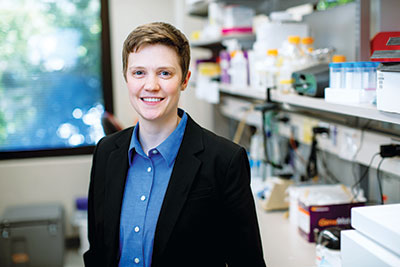Esketamine Approved For Treatment-Resistant Depression
Abstract
The first novel therapy for depression in decades holds promise, but it comes with a tight REMS program and a black-box warning.
On March 5, the Food and Drug Administration (FDA) approved Spravato (esketamine) nasal spray to be used in conjunction with an oral antidepressant for treatment-resistant depression in adults. Spravato is the first approved medication for depression with a novel mechanism of action since Prozac (fluoxetine hydrochloride) was approved in 1987.

Jennifer Vande Voort, M.D., says that there are several unknowns about esketamine, such as long-term efficacy and side effects, that warrant care in prescribing.
“I’m happy for patients who will have an additional option after not responding to other medications,” said Gerard Sanacora, M.D., Ph.D., director of the Yale Depression Research Program. “This is a real advance for the field in that we can offer something truly novel, which we haven’t had in decades. That being said, it’s going to be very important to use this medication responsibly moving forward.”
Sanacora is a coauthor on a 2018 paper published in the American Journal of Psychiatry that demonstrated significantly rapid improvement in depressive symptoms, including some measures of suicidal ideation, among depressed patients at imminent risk for suicide who took esketamine.
Because of the risks of sedation, dissociation, and misuse, Spravato is subject to a comprehensive Risk Evaluation and Mitigation Strategy (REMS) program and carries a black-box warning.
Patients can take Spravato only under the supervision of a health care professional in the office of a certified physician and must be monitored by a health care professional for at least two hours after the administration of the drug. The patient must remain on site until the health care professional determines it is safe for the patient to leave. In addition to the medication’s serious side effects, the black-box warning notes the risk of abuse and misuse.
“[The REMS program] was purposely made to limit how esketamine is distributed. Aside from concerns about its effect on individuals, there is also [a concern about] diversion,” Sanacora said. “There are some risks, so they are trying to be as responsible as possible in how this drug is distributed.”
Jennifer Vande Voort, M.D., a consultant in the Department of Psychiatry and Psychology at Mayo Clinic College of Medicine in Rochester, Minn., said there are a number of unknowns about esketamine.
“We don’t have a good sense of the long-term side effects. The urge to fill the need for a rapid-acting antidepressant medication has to be met with a measured response that recognizes that we still have knowledge gaps regarding its long-term efficacy, tolerance, and side effects,” Vande Voort told Psychiatric News.
Vande Voort stressed the importance of informed consent when prescribing Spravato for patients.
“Let them know about its sedating properties, dissociative properties, and addiction potential,” Vande Voort said. “Make sure they understand that it doesn’t work for everyone. The response rates are high, but it’s not 100 percent, and not everyone tolerates it.”
Sanacora agreed.
“There are effects on heart rate and blood pressure, and it can feel pretty strange. It can be hard even for clinicians to understand that it’s not like writing a prescription for Zoloft [sertraline],” he said.
Sanacora added that psychiatrists and other health professionals should set expectations with patients who inquire about Spravato.
“Some may think, ‘Oh, it’s something that will work in four hours. Why wait four weeks for Prozac?’ Be aware of the indication. It’s for people who have tried two other antidepressants, and it’s for use along with an oral antidepressant,” Sanacora said. “This is not for someone with mild depression. For those with mild depression, treatments like evidence-based psychotherapies that may take some time to work but have few risks and may provide more longer-term benefits may be a better choice.”
Spravato’s list price will be $590 for a 56 mg dose and $885 for an 84 mg dose. The wholesale acquisition cost for the month-long induction phase of therapy will run from $4,720 to $6,785, and maintenance doses provided either once or twice a week will render a monthly cost between $2,360 and $3,540.
“It will be interesting to see how insurance companies will cover it,” said Vande Voort. “Sometimes they don’t cover brand-new drugs on the market and we have to get prior authorization, and even then, insurance may deny coverage.”
“Price may place some limitation on access,” Sanacora said. “But for the population this is meant for, it’s comparable to ECT [electroconvulsive therapy] and rTMS [repetitive transcranial magnetic stimulation]. We need to compare this to the cost of other treatments for this specific population.”
Janssen has posted information about how to become a treatment center in accordance with the REMS. The medication is distributed only to certified health care settings and certified pharmacies. ■



